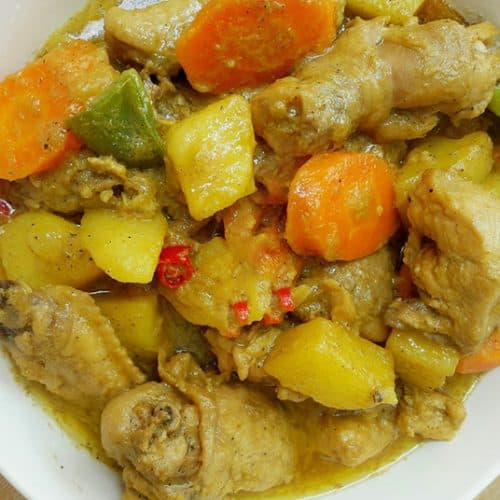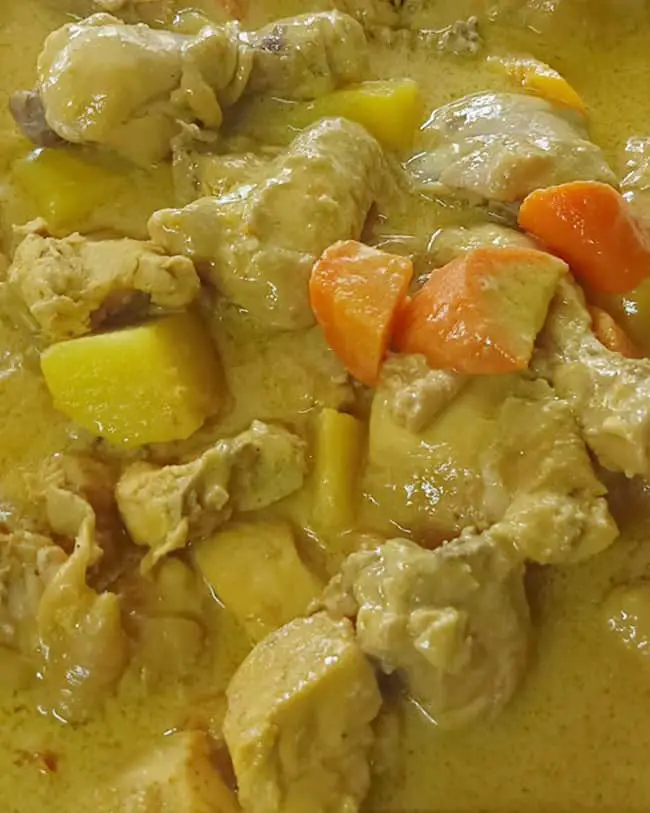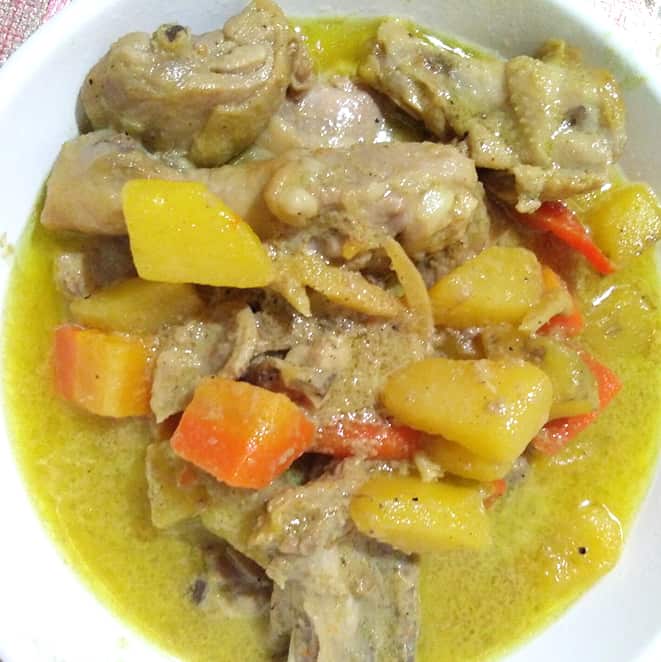Filipino chicken curry recipe with patis (Fish sauce)
Visit any eatery in the Philippines, and you’ll see a saucy chicken dish. You may ask yourself if this is an Indian dish or why it’s yellow, but one thing’s for sure: this looks good to devour!
This dish is Filipino chicken curry. Now you know what to order when the waitress comes over to you.
There are plenty of curries out there, but the Pinoy chicken curry is something truly special because it contains fish sauce! It’s served with warm white rice or pan-fried potatoes.
The rich curry sauce oozes flavor, and once you get a taste, you’ll be making this dish over and over again.
But this dish isn’t all chicken if you’re wondering. It also has carrots, bell peppers, potatoes, and green peas. So, it’s similar to hearty stew served at many Western restaurants.
Filipino-style chicken curry is very creamy, and it has a hint of sweetness to it from coconut milk.



Check out our new cookbook
Bitemybun's family recipes with complete meal planner and recipe guide.
Try it out for free with Kindle Unlimited:
Read for freeIn this post we'll cover:
Filipino chicken curry recipe with patis (Fish suce)
Ingredients
- 3 tbsp oil
- 3 potatoes peeled, quartered, and fried
- 1 lb chicken cut into serving pieces
- 3 cloves garlic minced
- 1 large onion quartered
- 1 tbsp patis (fish sauce)
- 3 tbsp curry powder
- Salt and pepper
- 1 cup water
- 1 red bell pepper cut into big squares
- 1 green bell pepper cut into big squares
- 3 celery stalks cut 1–1/2” long
- 1 cup coconut milk or evaporated milk
Instructions
- Pan fry the potatoes. Set aside.
- In the same pan, fry chicken pieces and brown a little.
- Add garlic and onion. Sauté for a few minutes until soft.
- Pour in patis and season with curry powder, salt, and pepper. Stir for 2 minutes.
- Add water. Cover and bring to a boil. Lower the heat and add celery, bell peppers, and fried potatoes. Simmer for 3 minutes or until half done.
- Add milk and stir occasionally. Cook for another 7 minutes (or less when using evaporated milk because the liquids will curdle).
- Remove from heat and serve hot.
Nutrition
Check out this video by Panlasang Pinoy on how to make Filipino chicken curry for some visuals:
Cooking tips
Typically, bone-in, skin-on chicken is used in Filipino chicken curries. The pan-fried chicken combined with the coconut milk curdles, and patis is to die for.
The key to making a great Filipino chicken curry is to use fresh ingredients. If you have access to fresh turmeric, that’d be ideal. You can also use fresh ginger, but ground ginger will work in a pinch.
The chicken curry recipe is a Pinoy version. It’s not too hot like the original curry from India or other Asian countries, although you can get a small taste of spice from the yellow curry powder.
It’s a milder version if you’re not into spicy foods. It’s also rich and somewhat sweet, thanks to coconut milk.
Coconuts tend to have a sweet taste, and the Philippines is a tropical country, so the coconuts are good on this side of the planet.
Carrots are also sweet, so it adds to the sweetness of the dish.
This chicken curry isn’t complete without other spices like garlic and onions. It adds to the richness of the meal!
Curry powder is a blend of spices, so it already contains turmeric, cumin, and other spices. You don’t need to add anything else.
Substitutions & variations
Some versions use other ingredients like quail eggs and napa cabbage. But the ones mentioned above are the most common ingredients in this Pinoy version.
The fish sauce (patis) is what makes this dish Filipino. It’s a type of sauce that’s made from fermented fish.
It gives the dish a salty flavor, and it’s a must in this recipe!
If you can’t find fish sauce, you can use soy sauce, anchovy sauce, or oyster sauce, which are all kind of similar. There are several fish sauce substitutes you can use to get the same umami flavor.
Some versions of this Filipino chicken curry recipe also require a bit of tomato juice. But you can skip it if you want to make an authentic version.
If you want a spicier chicken curry, add some chili peppers or ground pepper. If you want it sweeter, add more carrots.
If you want a more watery consistency, add more water or chicken broth.
You can also make this dish with chicken thighs or chicken breasts. Just adjust the cooking time because chicken breasts cook faster than thighs.
When it comes to curry powder, you can use the store-bought curry powder or make your own curry powder blend.
For a more authentic flavor, use fresh ginger, garlic, and turmeric. But ground spices work just as well.
Garam masala is a good substitute for curry powder. It’s an Indian spice blend that contains some of the same spices as curry powder.
How to serve and eat
Filipino-style chicken curry is served with steamed rice and can also be enjoyed with pan-fried potatoes.
If you don’t want to fry the potatoes, you can also boil or bake them. The potatoes are usually served on the side, but you can also add them to the dish. Some people even serve mashed potatoes.
It’s a dish that’s usually eaten with a spoon and fork. The chicken and vegetables are first spooned onto the rice, and then the curry sauce is poured over it.
It’s not hard to prepare the chicken curry recipe. It only takes some time to peel, slice, or chop the ingredients. The best part is, of course, eating!
As with any Filipino home setting, eating meals is a lot happier when you’re eating with friends and family. This is a Pinoy tradition that puts focus on the importance of togetherness.
Having said that, invite some people to eat with you.
Most of all, take this time to learn more about Filipino cuisine and culture.
How to store
Chicken curry is best enjoyed fresh. But you can also store it in the fridge for up to 3 days or in the freezer for up to 2 months.
I recommend storing it in the freezer for about 2 weeks if you want the chicken to retain its texture. You can thaw it the night before you’re ready to eat the meal again.
When reheating, use a microwave or do it on the stovetop. You can add curry powder and fish sauce to give the dish a more robust flavor.

Similar dishes
When it comes to Filipino chicken curry, there are a few dishes that are similar.
There are also other types of curry chicken recipes, but all versions taste delicious.
Some of these dishes include kalabasa at karne mechado (beef and squash stew), kare-kare (beef stew with vegetables in peanut sauce), afritada (chicken stew), and menudo (pork and liver stew).
These are all popular dishes in the Philippines that are enjoyed by many.
If you’re looking for something different, you can also try chicken binakol. This is a chicken soup that’s cooked in bamboo. The soup is made with young coconut, ginger, and lemongrass.

Try this Filipino version of chicken curry
This Filipino chicken curry recipe with patis is a delicious and hearty dish that’s perfect for any occasion. It’s easy to prepare and make, and won’t take up all of your time.
So if you’re looking for a delicious and easy-to-make meal, then this chicken curry recipe is the perfect choice!
While I prefer to eat it with fried potatoes, the curry is equally delicious paired with rice and a cool drink.
If you want to learn more about Filipino chicken curry, then check out this article.
Check out our new cookbook
Bitemybun's family recipes with complete meal planner and recipe guide.
Try it out for free with Kindle Unlimited:
Read for freeJoost Nusselder, the founder of Bite My Bun is a content marketer, dad and loves trying out new food with Japanese food at the heart of his passion, and together with his team he's been creating in-depth blog articles since 2016 to help loyal readers with recipes and cooking tips.
